by Lisa Cooke | Oct 28, 2016 | 01 What's New
This week, we set sail to the islands with new and updated genealogical records for Hawaiian and Irish genealogy. Passenger lists and denization records shine a light on ancestors who walked the shores of beautiful Hawaii and previously classified records are revealed in the Easter Rising collections for Ireland. Also this week, the Canadian Census for 1901, and records for Maine, Kentucky, and the country of Benin.

United States – Hawaii – Passenger Lists
This week at Ancestry, a new collection titled Hawaii, Passenger Lists, 1843-1898 is now available. It is searchable by name, birth, date of arrival, or date of departure. Specifically, this database includes passenger lists for ships arriving at and departing from ports in Hawaii between 1843 and 1898. This is both an index and a collection of digital images. Information may include a given and surname, age, gender, nationality or last place of residence, destination, ship name, and the date and place of departure or arrival. The names found in the index are linked to actual images of the manifests, digitized from originals at the Hawaii State Archives.
United States – Hawaii – Denization Records
Another new collection at Ancestry is the Hawaii, Denization Records, for 1846-1849, 1883-1898. Denization is the process used to grant a status similar to permanent residency and gave rights to denizens, such as the right to own land. These records are actually applications made by handwritten letters before 1895 and pre-printed application forms after that.
Information will vary, but may include:
- Name
- Age
- Occupation
- Place of origin
- Arrival date
- Record date
- Current residence
United States – Hawaii – Certificates of Identification
Lastly, Ancestry’s new collection Hawaii, Certificates of Identification for Chinese Arrivals, 1895-1898 may help find those connections back to mainland China.
This collection of certificates of identification for Chinese arrivals may include:
- Name
- Date of arrival
- Ship
- Permit number
- Photograph locator
Note: Photographs are not available in this collection. Photographs of arrivals were taken and kept in a Deposit Book. You can obtain copies of these photographs from the Hawaii State Archives using the locator information that is provided on each certificate.
Ireland – Easter Rising Collection
Findmypast has added over 48,000 additional records to their Easter Rising & Ireland Under Martial Law 1916-1921 collection. If you are not familiar with the Easter Rising, it took place on Easter Monday, April 24, 1916. A group of Irish nationalists announced the establishment of the Irish Republic and staged a rebellion against the British government in Ireland.
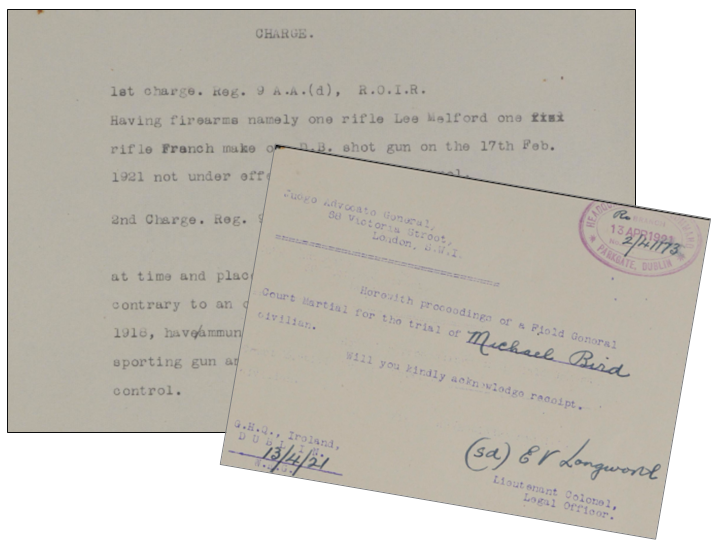
These were once classified records, but have now been digitized and can be browsed. These unique records document the struggles of life under martial law in Ireland and also contain details of both soldiers and civilians who participated or were affected by the Easter Rising of April 1916.
The collection contains the names of the hundreds of people who were detained and interned in prisons across Ireland, England, and Wales. Further, the internment files contain reports on individual detainees which record their charges, trial, and sentence as well as personal letters from prisoners or their relatives testifying to their innocence. Locating an ancestor in this collection would be a very special find.
Canada – Census
Findmypast has just added the Canada Census for 1901. It contains over 5.1 million records. The 1901 census was the first Canadian census to ask questions about religion, birthplace, citizenship, and immigration.
Each record includes a transcript and link to the digital image of the original census form. These census records will also list the name, date of birth, place of birth, marital status, relationship to head of household, race or tribe, immigration year, and naturalization year of each household member.
United States – Maine – Military
FamilySearch has added two new collections this week and one of them is Maine, World War I Draft Registration Index, 1917-1919. I don’t know if we have mentioned lately, but FamilySearch.org is free for everyone. This new collection for Maine is just one of hundreds available for genealogy records.
Records found in this collection generally conta in the following information:
in the following information:
- Name
- Place and date of birth
- Marital Status
- Residence
- Nationality and race
- Occupation
- Relatives’ names
United States – Kentucky – Marriages
This past summer, the Special Collections Research Center at University of Kentucky Libraries and the Fayette County Clerk’s Office developed a pilot project that will ultimately provide online access to Colored Marriage Indexes between the years of 1866-1882 and 1958-1968. The purpose of the project is to provide researchers with greater online access to these documents pertaining to African Americans in Kentucky.
The four volumes of the Colored Marriage Indexes are used to locate early marriage bonds of African Americans in Lexington, Kentucky. These indexes contain the name of each bride and groom and the page number of the marriage bond held at the Fayette County Clerk’s Office.
The digitized versions of the indexes are now freely available to the public on ExploreUK, UK’s digital library. The typed indexes have been run through optical character recognition (OCR) and are searchable.
Africa – Benin – Deaths
Death records may contain the following information:
by Lisa Cooke | Jan 15, 2017 | 01 What's New, Canadian, Genealogy Gems Podcast, Libraries
Jump start your Canadian genealogy research and celebrate Canada’s 150th birthday! Here are tips for you to start your Canadian genealogy research. Already started? Take it to the next level with resources at Library and Archives Canada.
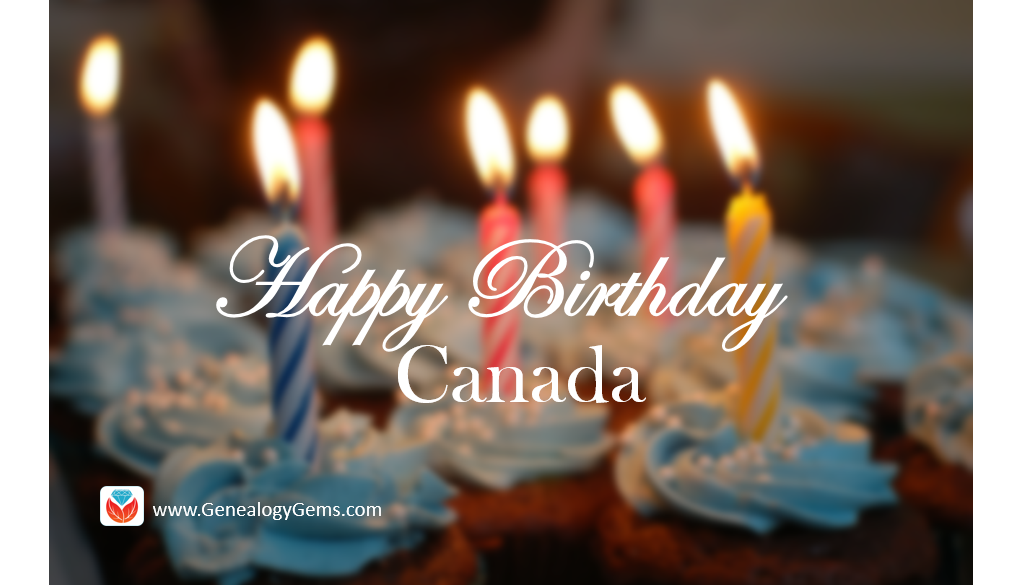
 Canada is celebrating 150 years of nationhood in 2017! To join the party, I invited Claire Banton from Library and Archives Canada to the Genealogy Gems podcast episode 199. We had a great chat about Canada’s history and its planned year-long celebration. And of course, our conversation quickly turned to tips for exploring your Canadian roots at Library and Archives Canada.
Canada is celebrating 150 years of nationhood in 2017! To join the party, I invited Claire Banton from Library and Archives Canada to the Genealogy Gems podcast episode 199. We had a great chat about Canada’s history and its planned year-long celebration. And of course, our conversation quickly turned to tips for exploring your Canadian roots at Library and Archives Canada.
Quick Tips for Canadian Genealogy Research
You can listen to our entire conversation for free in episode 199, but here are some quick take-away tips:

Claire Banton obtained her Masters of Library and Information Studies degree in 2006. She has worked in Reference Services at Library and Archives Canada for 10 years, where she has enjoyed learning something new every day. She is currently Chief, Orientation Services, where she works with an awesome team who help people search for information. She loves being an information detective and helping people overcome their research challenges.
1. Library and Archives Canada is very different from the average library.
It is both a national library (search the library catalog here) and a national archive (search the archival catalog here). And you don’t even have to have an account to search.
2. Start with the LAC website genealogy resources page whether you plan to visit in person or not.
You’ll find loads of free databases and some digitized records that haven’t been indexed yet, but are ripe for browsing. The topics page will tell you more about what is available for Canadian genealogy.
3. Familiarize yourself with the history of border crossings.
There was no border control from the US to Canada prior to 1908, so that means there are no Canadian records of earlier crossings. However, there is a database containing an index of aliens and citizens crossing into the U.S. from Canada via various ports of entry along the U.S.-Canadian border between 1895 and 1956 at FamilySearch.org and Ancestry.com.
4. Call LAC directly for quick Canadian genealogy answers.
Schedule a Skype call with a genealogy expert to get a more in depth answer. (This is awesome – well done LAC!) Set the expert up for success and get the most out of your call by providing background information ahead of time.
Click here to explore (and join) Canada’s 150th birthday celebration!
More Canadian Genealogy Tips
Search Canadian Passenger Lists for FREE at Library and Archives Canada
Here’s Why Quebec Church Records are a Great Place to Look for Ancestors
Canadiana: Canadian Digital Archive and Portal to the Past
by Lisa Cooke | Jun 18, 2013 | 01 What's New, Census, Records & databases
 Hands up, who wants to help prep the 1950 U.S. census for us all to explore?
Hands up, who wants to help prep the 1950 U.S. census for us all to explore?
The 1950 census won’t be released to the public for seven more years, but it took just longer than that to create the locational tools that millions of researchers have used to find their families on the 1940 census.
The dynamic duo of Steve Morse and Joel Weintraub, who produced the locational tools for the 1940 census on the Morse One-Step site, are recruiting 200+ volunteers to help transcribe enumeration district definitions and create urban area street indexes for the 1950 census.
Their “job description” for these volunteers sounds really meaty and hands-on: “These projects aren’t for everybody. Volunteers should have basic computer skills, typing skills, have access to the Internet, be detail people but not perfectionists, be independent workers and able to follow instructions, be patient enough to handle large amounts of information, and be comfortable with projects that may take weeks or months, not hours, to accomplish. You should be able to handle and manipulate images (jpgs) of maps and Enumeration District (ED) definition scans. A large computer monitor would be desirable but not essential. We will provide instructions for carrying out the work, and a place to ask questions. Volunteers may use some free programs to help speed up the entry process. We expect volunteers to make steady progress on their assignments, and we have the luxury of time right now to do it well.”
Learn more about the project here, and try the 1940 One-Step locational tools here.
by Lisa Cooke | May 6, 2017 | 01 What's New, British, Legacy Tree Genealogists
With about 1/3 of Americans claiming British ancestry, chances are that at some point you will need to extend your research across the Atlantic Ocean. Genealogical research in the British Isles has some important differences when compared to the United States. Guest blogger Kate Eakman, a Senior Researcher for Legacy Tree Genealogists, clarifies confusing terms and helps you get your research started on solid footing!

Britain? England? The United Kingdom?
When beginning British genealogy research, it’s important to first talk about the difference between British and English research. There are several terms which get used interchangeably but which really refer to different locations.
Great Britain is an island, the largest island in the British Isles.
On the island of Great Britain are three of the four sovereign nations which make up the United Kingdom, or the U.K.: England, Wales, and Scotland. Northern Ireland on the island of Ireland is the fourth country of the U.K.
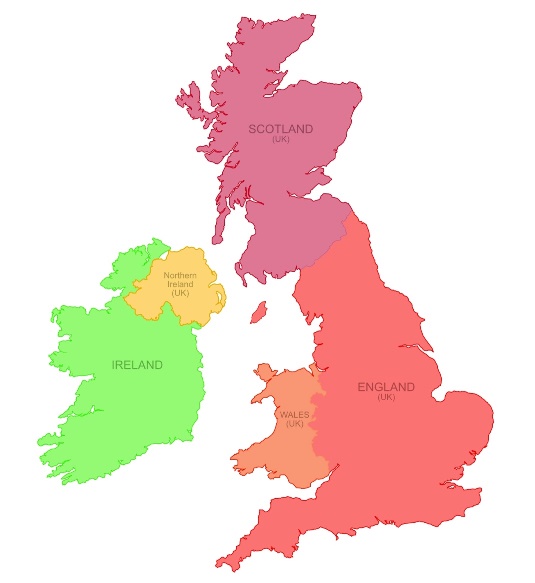
The four countries of the United Kingdom and the Republic of Ireland. Map courtesy Nate Parker.
Usually, when people talk about their British ancestors, what they really mean are their English ancestors. Although we Americans often treat the two words as interchangeable they really aren’t, and I suspect our English friends giggle a bit when they hear us misuse the words.
The four countries of the U.K. have some similarities but many important differences, and that is equally true for genealogical research. Rather than trying to explain all of those differences, this post will focus on English research.
One last thing to keep in mind when we talk about genealogical research in England is that today the country is divided into counties, which are sort of the equivalent of states in the U.S. Older records might refer to those counties as shires, and over time the borders have shifted, shires and counties were added, divided, or absorbed into each other. So a good map or two will be a useful tool to keep handy while you research your English ancestors.
Usually, when people talk about their British ancestors,
what they really mean are their English ancestors
What do you know?
Before beginning British genealogy research and making that leap across the pond, it is a good idea to consider what you already know about your English ancestors. Of course, you have a name, and you probably have an approximate date of birth.
- Were you fortunate enough to find the name of a town or county where that ancestor lived or do all of the census reports and vital records simply say “England”?
- If the ancestor arrived as an adult, what occupation did he pursue?
- When did he or she arrive in the U.S.? Are there any clues on the passenger list to tell you where to start looking?
- Once you have reviewed all of the information you have already acquired about your English ancestor, it’s time to start your research.
Beginning British Genealogy Research with the Census
The first step in most genealogical research is to study the existing census reports. Designed as a means to count the population for a variety of years, the census of Great Britain (including Scotland) is taken every ten years with the earliest records available in 1841. Due to very restrictive privacy laws, the most recent census available is from 1911, with one really valuable exception being the 1939 Register, available at FindMyPast.
Used for genealogical purposes, the census can give a snapshot of the family at the time the census was taken, as well as provide invaluable information such as the birthplace of the individual being recorded, occupation, birth year, and familial relationships. Elderly parents, or widowed mothers, aunts, or sisters, can be discovered living with younger members of the family.
Drawbacks of using the census for genealogical purposes include inaccurate name spellings, inaccurate age reporting, and inaccurate assumptions made by the enumerator. Another thing to keep in mind is that in the 1841 census the enumerated rounded down to the nearest five years the ages of people over 15. So a person who was listed as 25 could have been 25 through 29 years old.
It is important to remember that for the census reports through 1901 the enumerator copied the household information into books, and these copies are what we have today. Of course, when information is copied it is susceptible to error. The person who completed the census form may have had difficult-to-read handwriting, or the enumerator may have entered things on the wrong line. The individual reports have been kept for the 1911 census and offer a greater likelihood that the information they contain is very accurate.
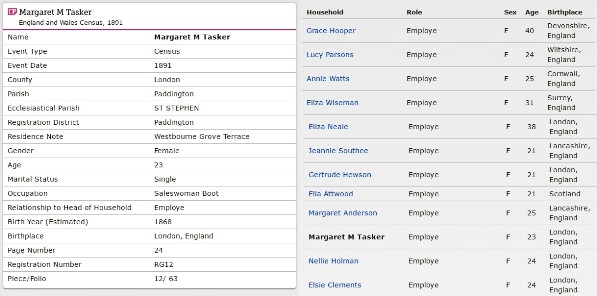
An example of a transcription from the 1891 English Census from Familysearch.org.
Detailed transcripts of English census records are available for free on FamilySearch and the images can be found for a fee at FindMyPast.
It is important to remember that for the census reports through 1901 the enumerator copied the household information into books, and these copies are what we have today.
Civil Registry of Vital Events
All English births, marriages, and deaths were required to be registered in a civil registration office beginning in July of 1837. In addition to the records themselves, there are indices which list the name of the person who was born, married, or died, the place where the event was registered, and the quarter and year in which the event occurred. Because the General Register Office (GRO) will only search one year on either side of the date provided, it is best, but not required, to include the index information when ordering documents from the GRO.
Free BMD is a free database which allows you the most freedom to search for the birth, marriage, and death index record of your relatives. You can enter whatever information you know including the place where the event happened, a specific year or range of years, age, and mother’s maiden name.
Depending on the time period, the index may be handwritten or mechanically printed. The information can then be used to order a copy of the actual record from the General Register Office (GRO) in England for about $10 per record.

An example of handwritten (left) and mechanically printed (right) birth index entries. Photos courtesy https://freebmd.org.uk.
The information contained in birth records includes:
- Name, date, and place of birth;
- Father’s name (if given at time of registration), occupation; and
- Mother’s name, maiden surname.
The parents’ places of birth were added after 1969, and the mother’s occupation is listed after 1984.
Marriage records include:
- Date and place of marriage;
- Name, age and marital status (spinster/bachelor, widowed, divorced) of the bride and groom;
- Occupation and usual address;
- Name and occupation of the fathers of the bride and groom, with a note if either man was deceased at the time of the marriage;
- Names of the witnesses;
- Name of the person who solemnized the marriage.
Death records in the United States are often relied upon to provide the names of the parents. English death records do not include that information and therefore are not as useful for genealogical purposes. Each death record includes:
- Name, date, and place of death;
- Date and place of birth (before 1969 a certificate only showed age of deceased);
- Occupation and usual address;
- Cause of death;
- The identity of the informant.
There are other records available, which we will talk about in a later post, which can be used to find and trace your English family members. The largest group are the religious records, and sometimes those can help you extend your family back in time to the 1600s – 400 years or more!
Beginning British Genealogy Important Take-Aways…
- “Great Britain” is an island. “The United Kingdom” is a country. And “England” is a country. Normally, when people are talking about their British ancestors they are referring to their English ancestors.
- England has counties, or what used to be known as “shires,” which function sort of like our states. The borders have changed over time, as have some of the names, so use a map when necessary to verify where you are researching.
- Census records are available from 1841 through 1911. Really good transcriptions are available for free at Family Search, or on the for-fee site Find My Past. And remember that age idiosyncrasy about the 1841 census.
- Finally, civil birth, marriage, and death records are available from the GRO. You can use the index listings to find the most likely match for your ancestor, and those can be found online at Free BMD.
Have fun and good luck finding your English ancestors!
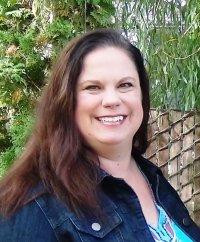 Kate Eakman is a Senior Researcher for Legacy Tree Genealogists, a worldwide genealogy research firm with extensive expertise in breaking through genealogy brick walls.
Kate Eakman is a Senior Researcher for Legacy Tree Genealogists, a worldwide genealogy research firm with extensive expertise in breaking through genealogy brick walls.
Click here to learn more about Legacy Tree services and its research team.
(Read our Disclosure and Affiliate Disclaimer on this page)
by Lisa Cooke | Sep 30, 2016 | 01 What's New, Records & databases
Search through new and updated genealogical records and histories galore. We are covering the world this week, reaching places we haven’t touched on before. Search records from familiar collections in Canada and the U.S., then check out what’s new in Russia and Ghana.

Canada – World War I
We know many of our readers have ancestry from Canada and we want to point your attention to the holdings at the Library and Archive Canada. This repository has many digital collections online and even includes a portrait portal with over 4 million images!

Today, we shine a light on just over 330,000 files now available online in the Soldiers of the First World War: 1914–1918 database.
The Soldiers of the First World War database is an index to the service files held by Library and Archives Canada for the soldiers, nurses, and chaplains who served with the CEF (Canadian Expeditionary Force.) Each box of service files holds approximately 50 files and envelopes. The individual’s name and service number or rank, if an officer, is written on each envelope. This database was organized by entering the name and number found on the outside of each of these file envelopes.
When the attestation papers and enlistment forms were digitized from the Attestation Registers (RG 9, II B8, volumes 1 to 654,) the images were linked to the database. Tip: When searching by name, be sure to look for alternate spellings as well.
The original paper documents can no longer be consulted, so your only option is to view these records digitally. For those items not yet digitized, you can order a copy from the Archives. As we mentioned, not all the documents have been digitized, but are are being done so regularly. Check back often!
United States – State and Local Histories
Findmypast has updated their United States, State & Local Histories collection and now holds 332 digitized books of state and local histories in PDF format. These histories come from Connecticut, Illinois, Indiana, Iowa, Maine, Massachusetts, Michigan, Nebraska, New Hampshire, New Jersey, New York, North Carolina, Ohio, Oregon, Pennsylvania, Rhode Island, South Carolina, Tennessee, Texas, Vermont, Virginia, Washington, Washington D.C., West Virginia, and Wisconsin.
You can narrow your specific search by publication year, title, county, and state, or search by keywords. These books often add clues and hints to the lives of our ancestors. You may also come across a biographical sketch of your ancestor which may hold key information you have been looking for.
Additionally, a sister collection titled United States, Family Histories may also prove fruitful. This collection contains over 930,000 images taken from 3,926 family histories and genealogies from all 50 states and several locations overseas. These PDF records can be searched by publication year, title, county, and state, page number, and key words. The publications emphasize tracing the descendants of the early, colonial immigrants to the United States. If you have a targeted ancestor that falls into that category, you will want to check these histories thoroughly.
United States – New York – Histories
The New York Genealogical and Biographical Record is the second oldest genealogical journal in the U.S. This week, Volume 27, Issue 2 (January 2016) of this publication is available at Findmypast. You can search or browse to find possible hints and clues to aid you in your research.
The New York Genealogical and Biographical Record is a quarterly publication, published since 1870. It publishes compiled genealogies that are documented, transcriptions of original records, and much more. To further learn about the NYG&B and their society, click here.
You might also be interested in the NYG&B’s quarterly review titled The New York Researcher. Formerly known as the NYG&B Newsletter, The New York Researcher has been published since 1970. Volume 147, Issue 2 (Summer 2016) of this publication is available now at Findmypast.
You will enjoy instructive articles on genealogical research techniques and New York resources, profiles of repositories, and profiles of genealogical societies across the State of New York.
Russia – Church Records
FamilySearch has digitized more than 2 million records in their collection titled Russia, Tatarstan Church Books, 1721-1939. Though these records are not indexed yet, you may find images of births and baptisms, marriages, deaths, and burials performed by priests of the Russian Orthodox Church in the republic of Tatarstan. These records were acquired from the state archive in that province.
Places are identified by their historical name and jurisdiction when it was part of the Russian Empire. If you are unsure of the history of your targeted location, remember what our Google Guru Lisa says…”Just Google It!”
The collection covers records from 1721 to 1939. These records are written in Russian, but remember that FamilySearch offers a helpful cheat sheet of common words and their translations!
There may be some restrictions on viewing these records. Whenever possible, FamilySearch makes images available for all users. However, rights to view images on their website are granted by the record custodians. In this case, the Russia, Tatarstan Church Books, 1721-1939 images can be only be viewed online at a Family History Center near you, or the Family History Library.
Ghana – Census
FamilySearch has also added the Ghana Census, 1984. This population census for Ghana is a complete enumeration of the 12.3 million people residing in Ghana as of midnight March 11, 1984. The census is divided into 56,170 localities. According to the government of Ghana, a locality is defined as any “nucleated and physically distinct settlement.” Localities may include a single house, a hamlet, a village, town or city. In some areas of the Upper West and Upper East Regions, these localities are based on kinship groups. Only those individuals, including foreign visitors, who were present in Ghana on March 11, 1984, were included in this census.
There have been some records lost in Ghana and so not all localities are available. Important: Be aware that the printed date on the census enumeration form usually says 1982, but this census was formally conducted in 1984.
The 1984 Ghana census may hold the following information:
- Detailed address of
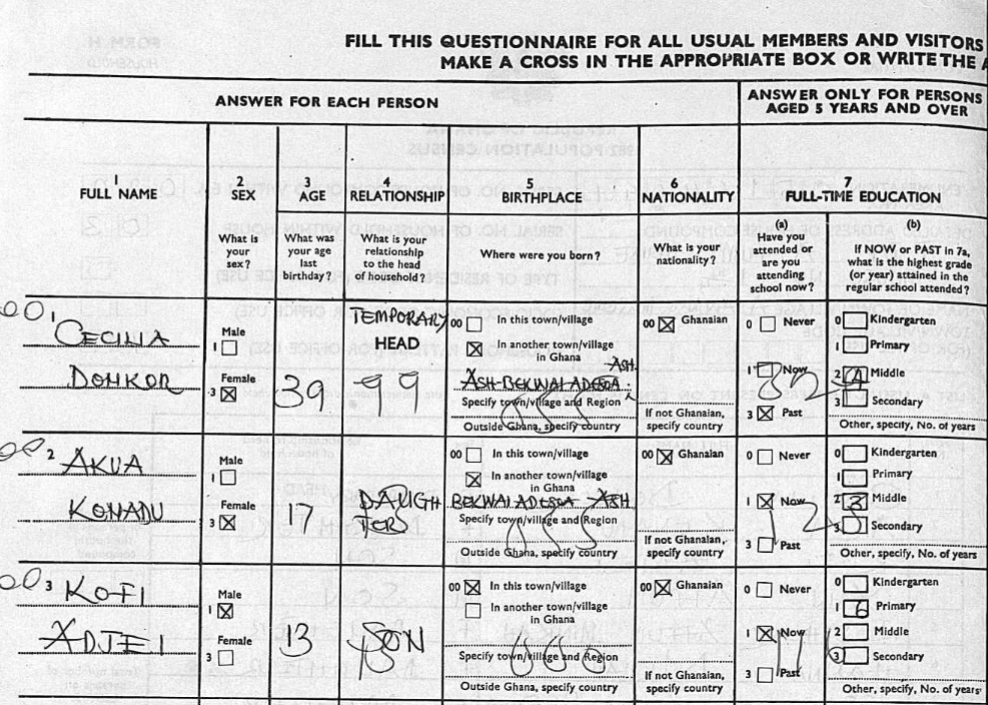 the house
the house
- Name of town/village
- Full name of members present on census night
- Relationship to head of household
- Gender, age, birthpla
ce, and nationality of each individual
- Level of education
- Occupation
- Employment status
- Names of visitors on census night
- Names of members absent on census night


 in the following information:
in the following information: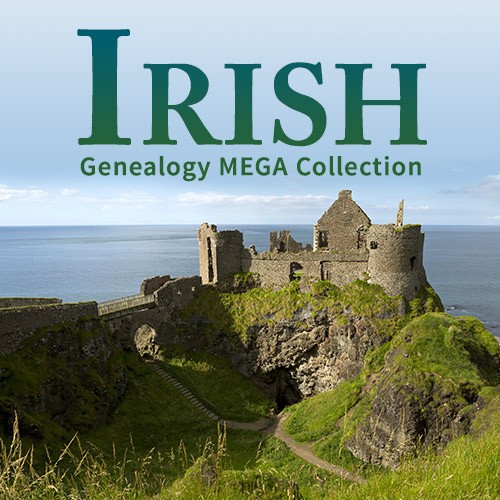


 Canada is celebrating 150 years of nationhood in 2017! To join the party, I invited Claire Banton from Library and Archives Canada to the
Canada is celebrating 150 years of nationhood in 2017! To join the party, I invited Claire Banton from Library and Archives Canada to the 







 the house
the house


